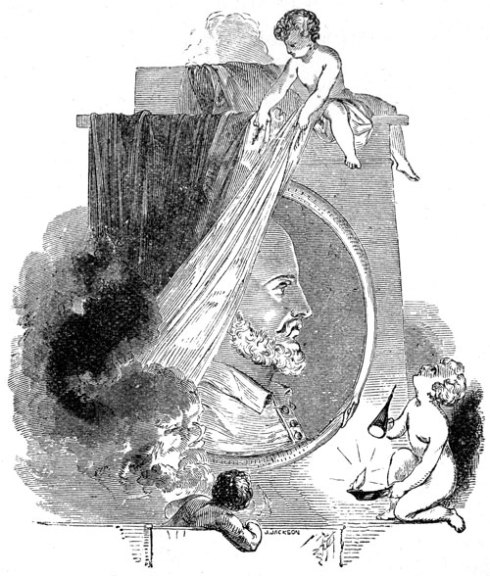
A quick post to wish William Shakespeare a Happy 450th birthday.
Raise a glass to the Bard tonight and, perhaps read a sonnet in his honor.
William Shakespeare was born on this day in Stratford-upon-Avon, in 1564. Today is the 450th anniversary of his birth
Although no official records of birth exist, the Holy Trinity Church in Stratford-upon-Avon has his baptism date listed as April 26, 1564, and the 23rd is generally agreed to be his birth date. He was the third of eight children born to John Shakespeare and Mary Arden Shakespeare.
William learned Latin, Greek and the Classics in grammar school, but never attended university.
At 18 he married Anne Hathaway (she was 8 years his senior and pregnant with their daughter Susanna). Two years later the couple had twins, Hamnet and Judith.
By 1592 he was in London acting and…
By 1594, he was not only acting and writing for the Lord Chamberlain’s Men (called the King’s Men after the ascension of James I in 1603), but was a managing partner in the operation as well. With Will Kempe, a master comedian, and Richard Burbage, a leading tragic actor of the day, the Lord Chamberlain’s Men became a favorite London troupe, patronized by royalty and made popular by the theatre-going public. … He had plays published and sold in octavo editions, or “penny-copies” to the more literate of his audiences. Never before had a playwright enjoyed sufficient acclaim to see his works published and sold as popular literature in the midst of his career. [Shakespeare Resource Center]
He retired back to Stratford-upon-Avon in 1610 and lived the largest house in town. He died at home on his 52nd birthday (although the day of his death is also not officially known.) He was buried on April 25, 1616.

Here are Shakespeare’s Plays: [Courtesy Shakespeare On-Line]
Tragedies
 Antony and Cleopatra (1607-1608)
Antony and Cleopatra (1607-1608)
The story of Mark Antony, Roman military leader and triumvir, who is madly in love with Cleopatra, Queen of Egypt.
Earliest known text: First Folio (1623).
 Coriolanus (1607-1608)
Coriolanus (1607-1608)
The last of Shakespeare’s great political tragedies, chronicling the life of the mighty warrior Caius Marcius Coriolanus.
Earliest known text: First Folio (1623).
 Hamlet (1600-1601)
Hamlet (1600-1601)
Since its first recorded production, Hamlet has engrossed playgoers, thrilled readers, and challenged actors more so than any other play in the Western canon. No other single work of fiction has produced more commonly used expressions.
Earliest known text: Quarto (1603).
 Julius Caesar (1599-1600)
Julius Caesar (1599-1600)
Although there were earlier Elizabethan plays on the subject of Julius Caesar and his turbulent rule, Shakespeare’s penetrating study of political life in ancient Rome is the only version to recount the demise of Brutus and the other conspirators.
Earliest known text: First Folio (1623).
 King Lear (1605-1606)
King Lear (1605-1606)
The story of King Lear, an aging monarch who decides to divide his kingdom amongst his three daughters, according to which one recites the best declaration of love.
Earliest known text: Quarto (1608).
 Macbeth (1605-1606)
Macbeth (1605-1606)
Macbeth is one of Shakespeare’s most stimulating and popular dramas. Renaissance records of Shakespeare’s plays in performance are scarce, but a detailed account of an original production of Macbeth has survived, thanks to Dr. Simon Forman.
Earliest known text: First Folio (1623).
 Othello (1604-1605)
Othello (1604-1605)
Othello, a valiant Moorish general in the service of Venice, falls prey to the devious schemes of his false friend, Iago.
Earliest known text: Quarto (1622).
 Romeo and Juliet (1594-1595)
Romeo and Juliet (1594-1595)
Celebrated for the radiance of its lyric poetry, Romeo and Juliet was tremendously popular from its first performance. The sweet whispers shared by young Tudor lovers throughout the realm were often referred to as “naught but pure Romeo and Juliet.”
Earliest known text: Quarto (1597).
 Timon of Athens (1607-1608)
Timon of Athens (1607-1608)
Written late in Shakespeare’s career, Timon of Athens is criticized as an underdeveloped tragedy, likely co-written by George Wilkins or Cyril Tourneur. Read the play and see if you agree.
Earliest known text: First Folio (1623).
 Titus Andronicus (1593-1594)
Titus Andronicus (1593-1594)
A sordid tale of revenge and political turmoil, overflowing with bloodshed and unthinkable brutality. The play was not printed with Shakespeare credited as author during his lifetime, and critics are divided between whether it is the product of another dramatist or simply Shakespeare’s first attempt at the genre.
Earliest known text: Quarto (1594).

Histories
 Henry IV, Part I (1597-1598)
Henry IV, Part I (1597-1598)
One of Shakespeare’s most popular plays, featuring the opportunistic miscreant, Sir John Falstaff.
Earliest known text: Quarto (1598).
 Henry IV, Part II (1597-1598)
Henry IV, Part II (1597-1598)
This is the third play in the second tetralogy of history plays, along with Richard II, Henry IV, Part 1, and Henry V.
Earliest known text: Quarto (1600).
 Henry V (1598-1599)
Henry V (1598-1599)
Henry V is the last in the second tetralogy sequence. King Henry is considered Shakespeare’s ideal monarch.
Earliest known text: Quarto (1600).
 Henry VI, Part I (1591-1592)
Henry VI, Part I (1591-1592)
The first in Shakespeare’s trilogy about the War of the Roses between the houses of Lancaster and York.
Earliest known text: First Folio (1623).
 Henry VI, Part II (1590-1591)
Henry VI, Part II (1590-1591)
Part two of Shakespeare’s chronicle play. Based on Hall’s work, the play contains some historical inaccuracies.
Earliest known text: Quarto (1594).
 Henry VI, Part III (1590-1591)
Henry VI, Part III (1590-1591)
Part three begins in medias res, with the duke of Suffolk dead and the duke of York being named Henry VI’s heir.
Earliest known text: Quarto (1595).
 Henry VIII (1612-1613)
Henry VIII (1612-1613)
Many believe Henry VIII to be Shakespeare’s last play, but others firmly believe that he had little, if anything, to do with its creation.
Earliest known text: First Folio (1623).
 King John (1596-1597)
King John (1596-1597)
In the shadow of Shakespeare’s second tetralogy of history plays lies the neglected masterpiece, King John. Although seldom read or performed today, King John was once one of Shakespeare’s most popular histories, praised for its poetic brilliance.
Earliest known text: First Folio (1623).
 Richard II (1595-1596)
Richard II (1595-1596)
More so than Shakespeare’s earlier history plays, Richard II is notable for its well-rounded characters.
Earliest known text: Quarto (1597).
 Richard III (1592-1593) The devious machinations of the deformed villain, Richard, duke of Gloucester, made this play an Elizabethan favorite.
Richard III (1592-1593) The devious machinations of the deformed villain, Richard, duke of Gloucester, made this play an Elizabethan favorite.
Earliest known text: Quarto (1597).

Comedies
 All’s Well That Ends Well (1602-1603)
All’s Well That Ends Well (1602-1603)
In 1767, a scholar named Richard Farmer concluded that this play is really the revision of Shakespeare’s missing Love’s Labour’s Won, which was likely written around 1592. It is considered a problem play, due primarily to the character Helena and her ambiguous nature. Is she a virtuous lady or a crafty temptress?
Earliest known text: First Folio (1623).
 As You Like It (1599-1600)
As You Like It (1599-1600)
As You Like It is considered by many to be one of Shakespeare’s greatest comedies, and the heroine, Rosalind, is praised as one of his most inspiring characters.
Earliest known text: First Folio (1623).
 The Comedy of Errors (1592-1593)
The Comedy of Errors (1592-1593)
This is Shakespeare’s shortest play, which he based on Menaechmi by Plautus.
Earliest known text: First Folio (1623).
 Cymbeline (1609-1610)
Cymbeline (1609-1610)
This play, modeled after Boccaccio’s Decameron, is often classified as a romance. It features the beautiful Imogen, considered by many to be Shakespeare’s most admirable female character.
Earliest known text: First Folio (1623).
 Love’s Labour’s Lost (1594-1595)
Love’s Labour’s Lost (1594-1595)
Love’s Labour’s Lost is a play of witty banter and little plot, written during the early part of Shakespeare’s literary career, when his focus was on fancy conceits and the playful nature of love.
Earliest known text: Quarto (1598).
 Measure for Measure (1604-1605)
Measure for Measure (1604-1605)
Considered a “dark” comedy, Measure for Measure was inspired by Cinthio’s Epitia and Whetstone’s Promos and Cassandra.
Earliest known text: First Folio (1623).
 The Merchant of Venice (1596-1597)
The Merchant of Venice (1596-1597)
The character of Shylock has raised a debate over whether the play should be condemned as anti-Semitic, and this controversy has overshadowed many other aspects of the play.
Earliest known text: Quarto (1600).
 The Merry Wives of Windsor (1600-1601)
The Merry Wives of Windsor (1600-1601)
The Merry Wives is unique amongst Shakespeare’s plays because it is set in Shakespeare’s England. It features the Bard’s beloved character, Falstaff.
Earliest known text: Quarto (1602).
 A Midsummer Night’s Dream (1595-1596)
A Midsummer Night’s Dream (1595-1596)
A magical exploration of the mysteries of love, and one of Shakespeare’s best-known comedies.
Earliest known text: Quarto (1600).
 Much Ado About Nothing (1598-1599)
Much Ado About Nothing (1598-1599)
The story of two very different sets of lovers, Beatrice and Benedick and Claudio and Hero. The witty banter between Beatrice and Benedick is the highlight of the play.
Earliest known text: Quarto (1600).
 Pericles, Prince of Tyre (1608-1609)
Pericles, Prince of Tyre (1608-1609)
Portions of Pericles are ripe with imagery and symbolism but the first three acts and scenes v and vi (the notorious brothel scenes) of Act IV are considered inadequate and likely the work of two other dramatists. The play was not included in the First Folio of 1623. In Shakespeare’s sources, Pericles is named Apollonius.
Earliest known text: Quarto (1609).
 The Taming of the Shrew (1593-1594)
The Taming of the Shrew (1593-1594)
The Taming of the Shrew revolves around the troubled relationship between Katharina and her suitor, Petruchio, who is determined to mold Katharina into a suitable wife.
Earliest known text: First Folio (1623).
 The Tempest (1611-1612)
The Tempest (1611-1612)
Hailed as a stunning climax to the career of England’s favorite dramatist, The Tempest is a play praising the glories of reconciliation and forgiveness. Some believe that Prospero’s final speeches signify Shakespeare’s personal adieu from the stage.
Earliest known text: First Folio (1623).
 Troilus and Cressida (1601-1602)
Troilus and Cressida (1601-1602)
Troilus and Cressida is difficult to categorize because it lacks elements vital to both comedies and tragedies. But, for now, it is classified as a comedy.
Earliest known text: Quarto (1609).
 Twelfth Night (1599-1600)
Twelfth Night (1599-1600)
Shakespeare loved to use the device of mistaken identity, and nowhere does he use this convention more skillfully than in Twelfth Night.
Earliest known text: First Folio (1623).
 Two Gentlemen of Verona (1594-1595)
Two Gentlemen of Verona (1594-1595)
The tale of two friends who travel to Milan and learn about the chaotic world of courting.
Earliest known text: First Folio (1623).
 The Winter’s Tale (1610-1611)
The Winter’s Tale (1610-1611)
The Winter’s Tale is considered a romantic comedy, but tragic elements are woven throughout the play. We have a first-hand account of a production of the play at the Globe in 1611. It is one of Shakespeare’s final plays.
Earliest known text: First Folio (1623).

For previous ritaLOVEStoWRITE.com Shakespeare posts click
Here for Insults
More Insults
Or just go to the search field on the right and type in Shakespeare (I’ve got a lot of Shakespeare on here.)


























![[Image courtesy jccastses.com]](https://ritalovestowrite.com/wp-content/uploads/2014/04/sean-bean-pic.jpeg?w=490)
![[Image courtesy www.poptower.com]](https://ritalovestowrite.com/wp-content/uploads/2014/04/sean-bean2.jpeg?w=490)



















![[From Flight of the Concords (HBO)]](https://ritalovestowrite.com/wp-content/uploads/2014/04/murray.jpg?w=490&h=276)









